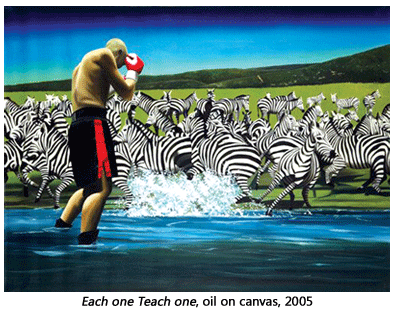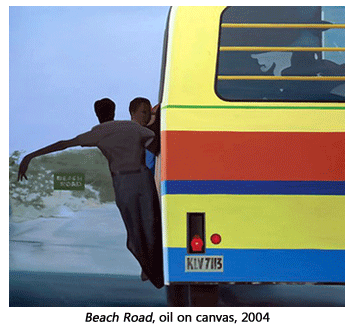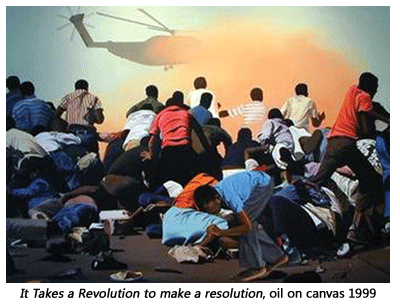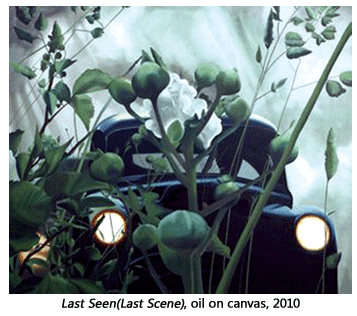- Prelude
- Editorial
- Subodh's 'return home'
- A Conversation with TV Santosh
- It's a War Out There
- Raqib Shaw
- Illusions in Red from a very British Indian Sculptor
- Stand Alone: Shibu Natesan
- Reading Atul Dodiya
- Bharti Kher: An Obsession for Bindis
- Bose Krishnamachari
- The Image - Spectacle and the Self
- From Self-depiction to Self-reference: Contemporary Indian Art
- GenNext: The Epitome of New Generation Art
- Kolkata's Contemporary Art A Look in the Mirror
- Innovation Coalesced with Continuing Chinese Qualities
- Kala Bhavana-Charukala Anushad Exchange Program
- Montblanc Fountain Pens
- Dutch Designs: The Queen Anne Style
- Bangalore Dance Beat
- Decade of change
- Distance Between Art & It's Connoisseur
- What Happened and What's Forthcoming
- 3rd India Art Summit
- New Paradigms of the Global Language of Art
- Black Brown & The Blue: Shuvaprasanna
- Art Events Kolkata
- Musings from Chennai
- Art Bengaluru
- Printmaker's Season
- Mumbai Art Sighting
- The Pause of Profound Stillness
- Previews
- In the News
- The Rebel Queen: An icon of her own times yet looked down upon
ART news & views
Stand Alone: Shibu Natesan
Volume: 3 Issue No: 14 Month: 3 Year: 2011
by Johny ML
The writer, in this essay goes through the works of Shibu Natesan and says that he is one of the undisputable masters of oil painting in Indian contemporary art scene.
In 1996-97, Shibu Natesan, who currently works between London and Trivandrum, while residing in Baroda did a series of oil paintings titled, Futility of Device, which was later exhibited in a solo show at the Sakshi Gallery, Mumbai. Shibu had not yet launched himself into the path of mediatic realism though he was intensely in love with both art historical and photographic images.  The deep dark feelings of the times immediately after the demolition of Babri Masjid (1992) and the riots that followed in Mumbai and Gujarat had severely affected him as a politically inclined and thinking individual. Shibu knew for sure that he was from a generation that had given all it had for art. The turbulence of 1980s had not subsided completely in the minds of artists when he entered his professional career by the beginning of the 90s. And Futility of Device became his visual response to the period of transition, which I would like to liken as a point where a black river flowed into a bleak sea.
The deep dark feelings of the times immediately after the demolition of Babri Masjid (1992) and the riots that followed in Mumbai and Gujarat had severely affected him as a politically inclined and thinking individual. Shibu knew for sure that he was from a generation that had given all it had for art. The turbulence of 1980s had not subsided completely in the minds of artists when he entered his professional career by the beginning of the 90s. And Futility of Device became his visual response to the period of transition, which I would like to liken as a point where a black river flowed into a bleak sea.
Strange are the tendencies of our times; today we teach our young art professionals to hate oil paintings for the simple reason that it is 'traditional'. Art history is not without its own share of vagaries and extravaganzas of ignorance. When it comes to the final counting of aesthetics, if at all a few artists remain who could be qualified as masters, Shibu Natesan would be a prominent one in that small lot. Shibu's medium is oil on canvas and he also works with water color on paper. And his works since the Futility of Device show, are highly polished, dexterously executed and heavily loaded by the image/information of our own times and that of history.  That's why, Nancy Adajania, in one of her articles suggests that Shibu could be called the pioneer of mediatic realism in India. By mediatic realism (though often people call it photo realism) what Nancy means is the artist's deliberate reference on/to mediatized images (images proliferated by media) made available by the novel forms of information technology.
That's why, Nancy Adajania, in one of her articles suggests that Shibu could be called the pioneer of mediatic realism in India. By mediatic realism (though often people call it photo realism) what Nancy means is the artist's deliberate reference on/to mediatized images (images proliferated by media) made available by the novel forms of information technology.
Having known the artist quite closely for almost three decades I could say it without a speck of doubt that Shibu is an 'unintentional' mediatic realist from the very beginning. Even before his graduation from Trivandrum Fine Arts College (1986), Shibu had this tendency of making paintings (mainly enamel on board) based on images culled out of newspapers and magazines, which were the only source of images at that point of time. When he joined the Print Making Department at the Faculty of Fine Arts, MS University, Baroda to do Masters, Shibu in a way continued this idea of referring to the available and sourced images vis-à-vis art history. While working on a series just before Futility of Device, the landscapes near and around Baroda became a source of inspiration and reference for him, to which he incorporated mental projections of visuals and visions.
It is with his Missing series and a series of almost monochromatic paintings of institutional buildings, done between 1995-97 Shibu becomes or comes to be hailed as a 'master of mediatic realism'. In Missing, Shibu painted a series of portraits of children who had gone missing from their homes and had appeared in the 'missing' section of the newspapers as 'passport size' photographs. These portraits, when viewed exclusively or seen simultaneously with the paintings of the institutions, cold, fortified and detached, one could see Shibu making a very clear political stance and statement (of course, aesthetics is his primary concern though) regarding the role of the ideological state apparatuses (as formulated by Althusser) that include hospital, schools, prisons, offices, military, police and so on in the lives of the 'missing' people. Suddenly, the ideological relationship between the missing people,  the circumstances in which they have gone missing, the agencies that have facilitated such a situation conducive for people vanishing and the state, is established, and a chain of questions are evoked in the minds of the onlooker.
the circumstances in which they have gone missing, the agencies that have facilitated such a situation conducive for people vanishing and the state, is established, and a chain of questions are evoked in the minds of the onlooker.
Shibu's sojourn in Amsterdam (which is not more than three years) during the mid-90s had helped him evolve his images in a more politically charged fashion. It is very pertinent to notice that almost a decade before the artists in India started doing large scale portraits (they call it political portraits) of film characters, servants, drivers, any ordinary person in the street or even friends and relatives and gaining international acclamation for that, Shibu had made the strongest visual expressions in his Missing series. Interestingly, when Peter Nagy showcased this particular series in Delhi, it came as a shock to many as Shibu had challenged the very aspect of oil painting as a medium that created 'beauty' by taking it into the level of monochromes, with revealing brush strokes and with no affected impastos. It took another decade for the viewers (not collectors as Shibu's works were already in major collections by that time) to really appreciate the validity of such political interventions through the medium of oil paint.
Shibu becomes one of the undisputable contemporary masters in Indian art scene by the new millennium as his works bloom with a new flourish, creative intensity and political as well as historical depth. An ardent lover of Reggae music, Shibu had already started his researches in Black politics and culture way back in mid 80s. However, it took another ten years for Shibu to come up with solid images that would reveal his ideological relationship with the politics of subaltern and dispossessed. For Shibu, it was not a fancy theme that could catapult him into international platforms. On the contrary, he delved deep into those images, which could be as suggestive as possible rather than making them overtly illustrative of his ideas. In the works like It Takes a Revolution to Make a Resolution (1999) and in Beach Road (2004) Jah Love (2005) and Each One Teach One (2005) one could see how subtly Shibu expresses his ideas on the people who are politically dispossessed all over the world and their courage to fight back not only through political/physical aggression but also through music and spirituality.
In the works like It Takes a Revolution to Make a Resolution (1999) and in Beach Road (2004) Jah Love (2005) and Each One Teach One (2005) one could see how subtly Shibu expresses his ideas on the people who are politically dispossessed all over the world and their courage to fight back not only through political/physical aggression but also through music and spirituality.
The deep political awareness and the unfathomable compassion for the lovers of freedom and independence have led Shibu to take different journeys with the same focus. While working between the studios in London, Baroda and Trivandrum, Shibu kept digging at family albums, local histories, history of the local saints and poets, in order to paint them and create icons out of them. Digging personal albums has become a fashion for many contemporary artists especially when they do installations, videos and digital works. As a pioneer, Shibu had created a constellation of images out of his family albums and inconspicuous history books. Doing a painting of an image from a family album and making a similar painting with the legendary poet Kumaran Asan (1873-1924), and the social reformer and spiritual leader Sree Narayana Guru (1856-1928), Shibu brings in a very unique visual narrative; a narrative of human striving for social independence and spiritual enlightenment.
The new millennium has given a new Shibu to the art world; he became almost unpredictable in his selection of images. At times, he is too existential and goes into a mental trip that would conjure up images like the artist himself going deep down in water full of glittering fishes or certain uncanny and eerie scenes where the artist does not bring any apparent personal references.  The sleekness of his paintings is irresistible and if I could use one phrase to qualify his works then I would say, Shibu's works are 'politically poetic' and 'poetically political'. The cheetah standing on an ultra modern car (Existence of Instinct, 2004), white ladies playing tennis under moon light (Moon Light Players 2005), the black boxer facing an invisible punch while a herd of zebras paces past (Each one Teach one, 2005) and so on provide ample evidences to see his poetry and politics.
The sleekness of his paintings is irresistible and if I could use one phrase to qualify his works then I would say, Shibu's works are 'politically poetic' and 'poetically political'. The cheetah standing on an ultra modern car (Existence of Instinct, 2004), white ladies playing tennis under moon light (Moon Light Players 2005), the black boxer facing an invisible punch while a herd of zebras paces past (Each one Teach one, 2005) and so on provide ample evidences to see his poetry and politics.
Shibu Natesan, for me is the undisputed master painter of our contemporary times. He has grown brighter by years, both visually and spiritually. His works reflect his spiritual inclination, which is not religious in the commonly understood terms. Also these works reflect how intricately Shibu weaves in his thoughts on international politics, social affairs and the stalemate situation of war as well as peace. Simple images become powerful vehicles of his ideas and one could see this power in the works such as External Affairs (2008), Last Seen/Last Scene (2010), House of Suspense (2008) and so on. Shibu Natesan's works stand alone and he has already made a resolution for them to be so.